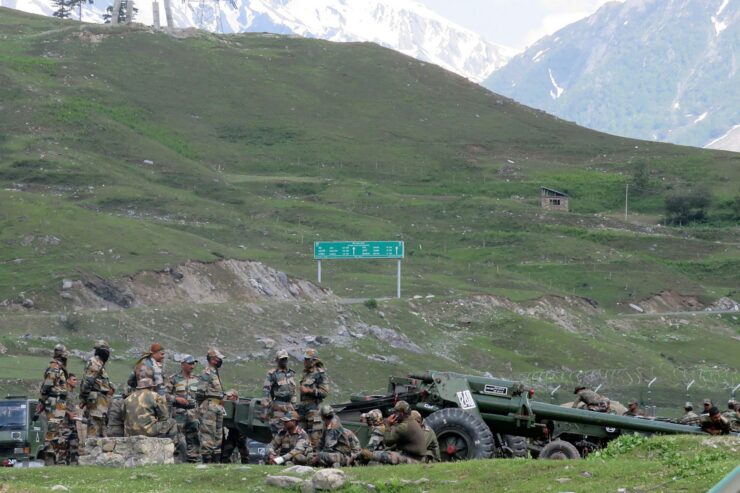
New Delhi: As the border tension continues with China, India has strengthened its border defences by stationing Chinook helicopters, towed howitzers and rifles as well as domestically-made supersonic cruise missiles and a new-age surveillance system in areas bordering eastern Tibet.
Not wanting to be caught unaware, India has deployed recently acquired US-made weaponry along its border, part of a new offensive force to bolster its capabilities. The build-up in India’s northeast is centred on the Tawang Plateau adjoining Bhutan and Tibet, a piece of land claimed by China but controlled by India. In 1959, the Dalai Lama fled to India across nearby mountain passes to escape a Chinese military operation. Three years later, both sides fought a war in the area.
Now US-manufactured Chinook helicopters, ultra-light towed howitzers and rifles as well as domestically-made supersonic cruise missiles and a new-age surveillance system will back Indian troops in areas bordering eastern Tibet. The weapons have all been acquired in the past few years as defence ties between the US and India have strengthened due to rising concerns about Chinese assertiveness.
Eastern Army Commander Lieutenant General Manoj Pande said that boots, armour, artillery and air support were being combined to make the force “agile, lean and mean so that we can employ faster.”
“The Mountain Strike Corps is fully operationalised,” he said. “All units including combat and combat support units are fully raised and equipped.”
While the two sides have engaged in talks to disengage, they have yet to agree on pulling back from a key flashpoint in another border area near the disputed area of Kashmir. Adding to the friction is a new Chinese boundary law that Beijing said was a “unified standard for strengthening border management.” India warned that the new law, passed last week, could affect ongoing border tensions, which China’s Foreign Ministry spokesman Wang Wenbin said was “undue speculation.”
The bulk of India’s fresh forces have gone to the east, where a formation of least 30,000 troops have been deployed over the past year. Prime Minister Narendra Modi’s government has been concerned about a repeat of a bitter 1962 battle in the Himalayas, when the People’s Liberation Army took Tawang as the under-prepared and poorly led Indian Army withdrew.
The area is crucial to India’s defences, as the borders stretching east to Myanmar are “poorly held” and the narrow corridor passing by Bhutan, Nepal and Bangladesh — which holds gas pipelines and railroads connecting central India to the northeast — is of “critical concern,” the commander said.
The Indian army’s offensive option along the Tawang Plateau, which is in the middle of those areas, would allow India to counter China as it steps up military activity in the area. General Pande said there was a “marginal increase in Chinese patrols in the eastern sector along the Line of Actual Control,” a disputed but de facto boundary between the two countries that runs along the Himalayas.
The LAC is patrolled by India and China, although General Pande said the scale and duration of PLA troop exercises on their side have increased since the stand-off in the eastern area of Ladakh last year. India has “adequate number of troops available,” the general said, without giving numbers.
A newly raised Indian Army aviation brigade, based about 300 kilometres (186 miles) south of Tawang, forms a critical component of the new offensive plan. This was the same base that US aviators took off from to fight the Japanese Imperial Army in China and assist the nationalist forces there in World War II. The Indian aviation brigade is now equipped with Chinook helicopters, which can ferry US-made light howitzers and troops quickly across mountains. It also has Israeli-made unmanned aerial vehicles that relay real-time pictures of the adversary round the clock.
“The Chinook are a game changer,” said Major Kartik, a pilot in the newly-formed brigade. “They offer mobility and manoeuvrability like never before — troops and artillery guns can be carried from one mountain ridge to other quickly.”
The preparations go beyond just boots and new equipment. Engineers in India are digging the world’s longest two-lane tunnel, which is 13,000 feet (4,000 meters) above sea level and runs underneath a critical mountain pass currently accessible by a 317-kilometer meandering road to the disputed border. Construction is ahead of schedule and the structure will be operational by next June, said Colonel Prakshit Mehra, a project director of the tunnel. “Currently snow clearance of the pass requires massive effort, and even then only certain kind of vehicles can cross,” he said. “The tunnel will reduce travel time by hours, allowing faster and unhindered movement of troops round the year.” The tunnel, once operationalised, ensures that India can move its troops without detection from China, according to a senior military commander who asked not to be identified.
A new road has been constructed close to the disputed border to move troops and supplies. A second one running along the eastern borders of Bhutan connecting the disputed border to the plains below is nearly complete, throwing up more possibilities for military commanders.
“We are more comfortable than what we were a few years ago,” said Major General Zubin A. Minwalla, commander of the 5-Mountain Division of the Indian Army.








